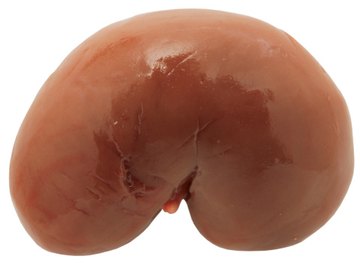
The kidneys are the bean shaped organs that are about the size of a fist located behind the abdomen. They remove extra water and waste from the blood and produce urine. Science projects about the kidneys can be easily constructed to show functions of the kidneys and problems that can occur.
Kidney Model
Science projects about the kidneys should demonstrate their parts and function in the body. Create a clay model about the size of a human fist and bean shaped. On the upper part of each kidney is the adrenal gland which brings blood to be filtered by the kidneys. The other part of the kidneys has tubes called ureters, which run to the bladder and carry the waste produced from filtering the blood. Label each part and research its function to include this information in your project. Build models of both a healthy kidney and one that doesn’t function properly due to disease or age, for comparison.
Kidney Stones
A kidney stone develops from crystals that separate in the urinary tract. Determine if caffeine plays a role in forming or preventing kidney stones. Using calcite stones to represent kidney stones break several stones to similar size and place into separate baby food jars. Add a liquid that contains caffeine in different concentrations such as cola, melted chocolate, tea, coffee to each jar and label the jars. Place a light over each jar to warm them to the temperature of your body (37 degrees Celsius). Observe for two months. During this time, add a small amount of hydrochloric acid to each jar to simulate the body’s stomach acids. Did the caffeine solutions cause the calcite stones to shrink or have no effect?
Urine Production
The kidneys remove waste from the blood and send it to the bladder. Conduct an experiment on how fast the kidneys process different fluids. Drink a liter of water quickly. Wait 20 minutes and then collect your urine in a beaker. Record the volume and color. Use a pH testing strip to record the pH as well. Repeat four times so that you have five samples collected 20 minutes apart. Do the same for two more liquids such as an energy drink and coffee or cola. Determine which fluid produced more urine, which had a higher pH and examine why. For example, energy drinks cause a high output of urine because most energy drinks contain saline. This project can be done with other types of drinks to determine how fast the kidneys process different ingredients.
Filtration System
The kidneys work together as the body’s filtration system. An easy science project for any age is to demonstrate how this works. Mix sand, water, and food coloring in a jar. Half fill another jar with water. Place cheese cloth over the top and slowly pour the sand mixture over it. The filter will allow the colored water through, leaving the sand behind. The water inside the jar changes color because of the food coloring. Dump the water and repeat the experiment adding more water to the sand mixture before pouring on the cheese cloth. The color of the sand and the filtered water will fade as new water is added. This demonstrates how the kidneys clean toxins from the blood.
References
About the Author
Renee Miller began writing professionally in 2008, contributing to websites and the "Community Press" newspaper. She is co-founder of On Fiction Writing, a website for writers. Miller holds a diploma in social services from Clarke College in Belleville, Ontario.
Photo Credits
Stockbyte/Stockbyte/Getty Images
